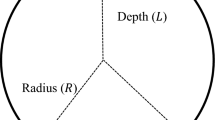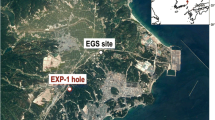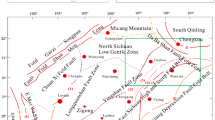The in-situ stress information underground is of crucial importance for drilling and reservoir development. As the cost of direct stress measurements is high and only limited information can be obtained, the application of wellbore imaging devices made it possible to interpret the local stress state more economical. Breakout azimuths revealed by well logs are widely used to determine principal stress directions in traditional method, however strength anisotropic related to bedding planes may greatly affect breakout azimuth, width and depth, which can result in misleading for in-situ stress interpretations. Based on weak-plane borehole stability model and Mogi-Coulomb matrix strength criterion, we analyzed the relationship between in-situ stress and breakout geometry (azimuth, width and depth) both in isotropic and anisotropic formation. The results show that the azimuth of breakout is controlled by weak plane’s azimuth, while steep dipping bedding plane widen the breakout and make it extending into rocks. For specific strata with determined property, breakout geometry will change regularly with the increase of the principal stress ratio. A breakout accident observed in well WFSD-2 help to illustrate the method and the magnitude of the maximum horizontal principal stress is determined.





Similar content being viewed by others
References
Zoback, M.D., 2007. Reservoir Geomechanics. Cambridge University Press, New York.
Haghi, A.H., Kharrat, R., Asef, M.R., 2011. Simulation and analysis of production induced reservoir compaction using geo-mechanical formulation of fracturing technology (GFFT) for stress prediction, SPE. Int. Petro. Tech. Con. (IPTC), IPTC-14832-PP, Bangkok, Thailand.
Amadei, B., Stephannson, O., 1997. Rock Stress and its Measurement. Chapman and Hall, New York.
Fjaer, E., Holt, R., Horsrud, P., Raaen, A., Risnes, R., 2008. Petroleum Related Rock Mechanics, 2nd ed. Elsevier, Amsterdam.
Zang, A., Stephannson, O., 2010. Stress Field in the Earth’s Crust. Springer, Amsterdam.
Brudy M., 1995. Determination of in-situ stress magnitude, orientation to 9 km depth at the KTB site. In: Geophysics. Karlsruhe, Germany: University of Karlsruhe.
Lund B., Zoback M.D., 1999. Orientation and magnitude of in situ stress to 6.5km depth in the Baltic Shield. Int. J. Rock Mech. Min. Sci. 36, 169–90.
Gough, D.I., Bell, J.S., 1982. Stress orientations from borehole wall fractures with examples from Colorado, east Texas, and northern Canada. Can. J. Earth Sci. 19, 1358-1370.
Acknowledgments
The authors gratefully acknowledge the financial support of the National Nature Science Foundation of China (No.52074018, No.52274001), the financial support of fundamental Research Funds for the Central Universities (buctrc202017).
Author information
Authors and Affiliations
Corresponding author
Additional information
Translated from Khimiya i Tekhnologiya Topliv i Masel, No. 6, pp. 62–67 November – December, 2022.
Rights and permissions
Springer Nature or its licensor (e.g. a society or other partner) holds exclusive rights to this article under a publishing agreement with the author(s) or other rightsholder(s); author self-archiving of the accepted manuscript version of this article is solely governed by the terms of such publishing agreement and applicable law.
About this article
Cite this article
Sun, T., Ding, L. & Zhang, Y. In-Situ Stress Determination in Anisotropic Formation Underground with the Help of Wellbore Breakout Observations. Chem Technol Fuels Oils 58, 983–989 (2023). https://doi.org/10.1007/s10553-023-01480-1
Published:
Issue Date:
DOI: https://doi.org/10.1007/s10553-023-01480-1




